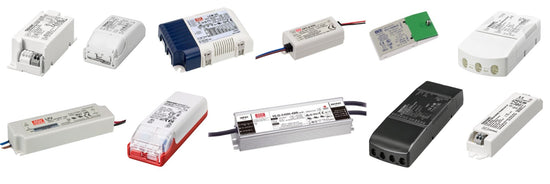How to Choose an LED Driver
Welcome to this guide to choosing an LED driver. This guide includes the basic factors to consider when choosing an LED driver for your application. There is also information behind these factors to help you to make your decision. LED Spares stock a wide variety of LED drivers and power supplies from some of the most popular brands.
Constant Current vs. Constant Voltage
All drivers are either constant current (CC) or constant voltage (CV), or both. This is one of the first factors you need to consider. This decision will be determined by the LED or module you will be powering, the information for which can be found on the LED’s datasheet.
What is Constant Current?
Constant current (CC) LED drivers keep a constant electric current throughout an electronic circuit by having a variable voltage. CC drivers are often the most popular choice for LED applications. CC LED drivers can be used for individual bulbs or a chain of LEDs in series. A series means that the LEDs are all mounted together in line, for the current to flow through each one. The disadvantage is if the circuit is broken, none of your LEDs will work. However they generally offer better control and a more efficient system than constant voltage. Click on the link below for a range of our Constant Current LED drivers
What is Constant Voltage?
Constant voltage (CV) LED drivers are power supplies. They have a set voltage that they supply to the electronic circuit. You would use CV LED drivers to run multiple LEDs in parallel, for example LED strips. CV power supplies can be used with LED strips that have a current limiting resistor, which most do. The voltage output must meet the voltage requirement of the entire LED string. Click on the image below for a range of our Constant Voltage LED Drivers
What is Constant Current / Constant Voltage?
Some LED drivers may feature both options of CV and CC. As standard they run as CV but, when output current passes the rated current limit, they switch to a CC mode. This functionality is suitable for applications which require a flexible LED Driver. Applications for CV OR CC?
CONSTANT CURRENT CONSTANT VOLTAGE
LED Downlights LEDs in parallel
Office Lighting LED Strips
Residential LED Lighting LED Light Engines
Mood Lighting Moving Signs
Retail Lighting Stage Lighting
Entertainment Lighting Architectural Lighting
LED Signs Street Lighting
High Bay
Outdoor Lighting
FACTORS TO CONSIDER
Output Current (mA)
When using a Constant Current LED driver, observe the current requirements of your chosen LED(s). The CC driver should then reflect that value output. LEDs data sheets state what they require, with the value given in amps (A) or milliamps (mA). 1 A = 1000 mA There are also variable and selectable output current drivers. They give either a range, for example 0 mA to 500 mA, or stepped values like 350 mA, 500 mA, 700 mA. Your LED must fall within the chosen value(s). LEDs can be run at a lower current to help extend its life expectancy. Using a higher current could wear the LED out a lot quicker.
Output Power (W)
This value is given in watts (W). Use an LED driver with at least the same value as your LED(s). The driver must have a higher output power than your LEDs require for extra safety. If the output is equivalent to the LED power requirements, it is running at full power. Running at full power may cause the driver to have a shorter life span. Similarly the power requirement of the LEDs is given as an average. With tolerance added on top for multiple LEDs, you need a higher output power from the driver to cover this.
Output Voltage (V)
This value is given in volts (V). For constant voltage drivers, it requires the same output as your LED’s voltage requirements. For multiple LEDs, each LED voltage requirement is added together for a total value. If you are using constant current, the output voltage must exceed the LED requirements.
IP Rating
How water/dust resistant does your LED driver need to be? If your driver is going somewhere where it may come into contact with water/dust, you could use an IP65 rated driver. This means it is protected from dust and any water projected at it. If you need something water-tight, you might need a driver with an IP67 or IP68 rating. The IP rating is given as a number. The first digit represents solid objects and the second is liquids. Here are the definitions:

Termination Method
How will you connect your LED driver to your chosen application? Some LED drivers come with flying wires attached. Alternatively you could need to purchase wires separately. Screw or grip wire terminals also exist for quick mounting of cables to the driver.
Dimming systems
If your LED light source is being dimmed it is very important to match up any replacement driver to the existing version or if a new instato the correct dimming system. the most popular systems are as follows.
DALI
1-10V
Push Dim
Leading/Trailing edge
PWM
I will be posting another blog shortly on dimming LED's so please be sure to subscribe to our newsletter on the website.
I hope you found this article useful, if you require any further technical support or help replacing any LED Drivers please contact our sales team.




